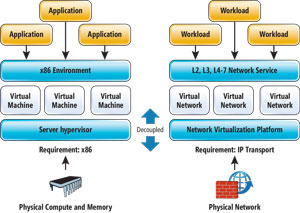News
A Software-Defined Networking Primer
What it is, why you should care and the two primary offerings.
Software-defined networking (SDN) is coming to an enterprise datacenter near you. Count on it.
The new-age networking technology is evolving and maturing, moving from early roots in academic exercises to proof-of-concept testing labs to tentative adoption by Web-scale giants, carriers, service providers and telecom operators. Next is the enterprise datacenter. Next is you.
Here's a primer on what SDN is, the benefits it provides, exactly who's providing those benefits, and how they're doing it.
Defining SDN
First is the definition. That's hard enough with such a nascent technology, still shaking itself out in a hodgepodge of would-be standards bearers, commercial stewards with different approaches and agendas, and various open source projects.
To help cut through the commercial bias, let's start off with the vendor-agnostic Open Networking Foundation (ONF), which bills itself as "a user-driven organization dedicated to the promotion and adoption of SDN through open standards development."
It says SDN is "the physical separation of the network control plane from the forwarding plane, and where a control plane controls several devices." (See Figure 1.) Furthermore, it's "an emerging architecture that is dynamic, manageable, cost-effective and adaptable, making it ideal for the high-bandwidth, dynamic nature of today's applications."
 [Click on image for larger view.]
Figure 1. Comparing server virtualization with software-defined networking.
[Click on image for larger view.]
Figure 1. Comparing server virtualization with software-defined networking.
With that separation of network planes, network "intelligence" is moved from proprietary hardware to the control plane, managed by a software controller that sees the entire network like one single entity that it can control as needed.
Say Goodbye to Proprietary
And with that de-emphasis of hardware, another key tenet of SDN emerges: the replacement of high-functioning, proprietary hardware with less-expensive, commodity whitebox (or bare-metal) switches that route traffic as they're told.
In a nutshell, SDN provides increased network agility, abstraction, automation, orchestration/control and visibility.
So there's your "what" and "why." Now for "who."
Cisco Disruption?
When you think of networking, you think of Cisco Systems Inc. When you think of network virtualization, you think of VMware Inc. Both companies avoid heavy use of the term SDN in their product marketing, while providing products that the rest of the world sees firmly ensconced in the SDN camp. While several open source SDN solutions are available from organizations such as the ONF, along with a host of proprietary offerings from numerous second-tier vendors, I'll focus on Cisco and VMware here.
Cisco, as the proprietary-networking kingpin, is in the most danger of SDN disruption, according to various analysts, experts and industry pundits.
Recognizing the threat, Cisco had some fits and starts in its reaction to SDN, such as the Open Network Environment (ONE) introduced in 2012. Since then, it has consolidated that product's "application-led" philosophy and released Application-Centric Infrastructure (ACI), which it has described as being "better than SDN." The company says it "reduces TCO, automates IT tasks, and accelerates datacenter application deployments. It accomplishes this using a business-relevant SDN policy model across networks, servers, storage, security and services."
It still uses proprietary components, however, such as the Nexus 9000 switches and its own Application Policy Infrastructure Controller (APIC), as opposed to open source controller alternatives such as the OpenDaylight project.
Cisco is hedging its bets, though, and participates in the OpenDaylight project and other SDN-related industry initiatives, such as the Open Network Operating System (ONOS).
Coincidentally, another OpenDaylight member is VMware, an SDN competitor Cisco has vowed to "crush" in the marketplace.
VMware NSX
VMware positions its networking virtualization platform, NSX, as a component of the software-defined datacenter. "In contrast to SDN, in which hardware remains the driving force, VMware network virtualization technology truly decouples network resources from underlying hardware," the company says.
NSX is described by VMware as "a hypervisor networking solution designed to manage, automate and provide basic Layer 4-7 services to virtual machine traffic." VMware developed the NSX overlay approach through its 2012 acquisition of Nicera Inc. in 2012.
"ACI and NSX provide very different approaches to solving networking challenges," said Gartner analyst Andrew Lerner in a recent blog post. "ACI is a programmable Ethernet Fabric that integrates hardware and software, while NSX is a network overlay."
Strategic Choices
Other options abound, of course, but conservative enterprises may be inclined to pick one of the two industry leaders for help in their SDN forays.
"Choosing between ACI and NSX is a strategic network decision, and is way beyond just a networking thing," Lerner said. We'll save that discussion for a later time.
Another OpenDaylight member is VMware, an SDN competitor Cisco has vowed to "crush" in the marketplace.
About the Author
David Ramel is an editor and writer at Converge 360.